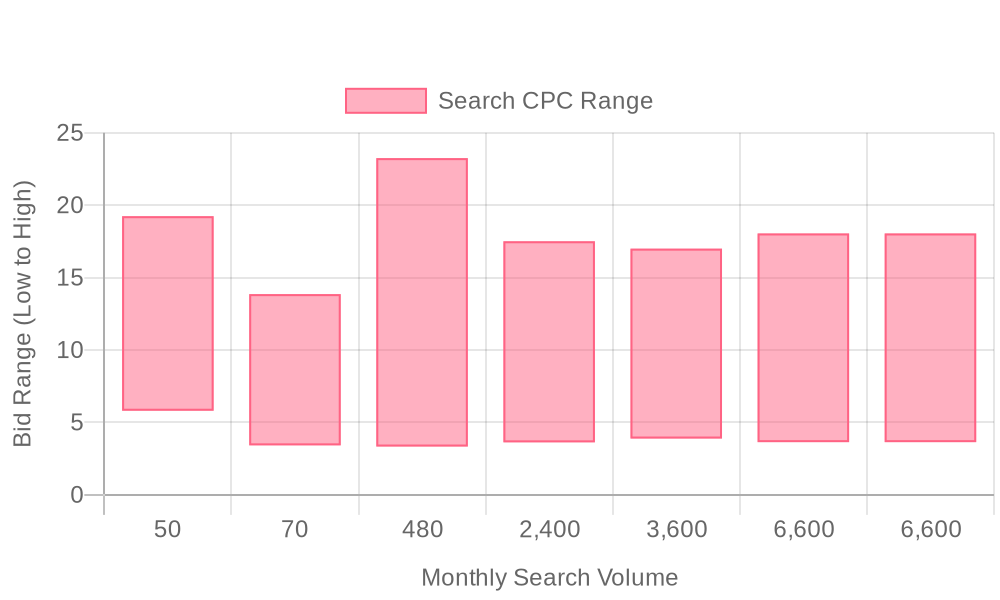
Supercharge your lead generation with a FREE Google Ads audit - no strings attached! See how you can generate more and higher quality leads
Get My Free Google Ads AuditFree consultation

No commitment
Supercharge your lead generation with a FREE LinkedIn Ads audit - no strings attached! See how you can generate more and higher quality leads
Get My Free Google Ads AuditFree consultation

No commitment
Supercharge your lead generation with a FREE Meta Ads audit - no strings attached! See how you can generate more and higher quality leads
Get My Free Google Ads AuditGet My Free LinkedIn Ads AuditGet My Free Meta Ads AuditFree consultation

No commitment
Supercharge your lead generation with a FREE Google Ads audit - no strings attached! See how you can generate more and higher quality leads
Get My Free Google Ads AuditFree consultation

No commitment
In the competitive landscape of residential contracting, leveraging Google Ads effectively can be a game-changer. Contractors often face challenges such as tracking incomplete B2B profiles that cause wasted ad budgets. A well-defined strategy helps in attracting local clients at their precise moment of need, bridging online and offline marketing efforts, and ultimately driving more conversions. This guide will walk through structuring successful Google Ads campaigns tailored for the residential general contractor sector, ensuring your business captures the right attention and converts clicks into contracts.

Residential general contractors face a dynamic digital landscape where every lead counts. To consistently fill sales pipelines, a disciplined approach to Google Ads for home builders ensures every interaction is traceable and relevant, while leveraging real-time audience data delivers hyper-targeted outreach that maximizes lead quality.
Leaders in this industry recognize that maximizing campaign value requires more than just ad placements. Unifying intent data, engaging audiences at the right moment, and capturing qualified opportunities are essential for predictable growth. For more on connecting digital touchpoints to sales outcomes, explore our comprehensive guide to account-based marketing.
Setting clear objectives is foundational. For residential general contractors, this means distinguishing between high-value actions like phone calls, form fills, or on-site appointment bookings. Incomplete or poorly defined goals can lead to wasted ad spend and missed revenue opportunities. Review strategies used by top-performing home services businesses in digital marketing case studies to clarify which KPIs matter most for your business.
Align campaign objectives with broader business outcomes. When campaign KPIs mirror revenue targets and sales priorities, every ad dollar works toward the bottom line. Precise goal tracking also informs budget allocation and creative direction, eliminating ambiguity and preventing resource misalignment.
Generic keyword lists quickly lose their competitive edge. To remain relevant, contractors must identify high-intent searches—such as "residential contractor near me" or "home renovation leads"—that signal a real purchasing need. Access a list of top-performing Google Ads keywords for contractors to optimize your ad targeting from the start.
Dynamic keyword strategies go beyond manual updates. With advanced platforms, marketers can automatically update negative keyword lists and adapt targeting as market trends shift. This reduces exposure to irrelevant traffic and positions campaigns for optimal cost-per-lead by tracking live search behaviors and reallocating spend to top-performing keywords.
Effective ad copy captures attention and builds trust from the first impression. Headlines should feature strong offers like "Free Consultation" or "Immediate Project Start Dates" to separate genuine leads from casual browsers. Discover actionable tips for writing high-converting Google Ads copy and integrate trust signals—such as certifications and client testimonials—to boost response rates.
Ad extensions enhance visibility and drive engagement. Integrate structured snippets and callouts to showcase specialties and service areas directly in search listings. Testing variations of calls-to-action and highlighting unique value propositions can increase click-through rates and set the stage for downstream conversions.
Every click should land on a page purpose-built for conversion. Learn how to create optimized landing pages for Google Ads to match ad group intent and keep prospects moving toward action.
Conversion-focused elements include prominent CTAs, embedded project galleries, and visible proof of licensing or insurance. Reducing form fields and leveraging mobile-friendly layouts further increase submission rates. Connect your landing page and CRM using automatic data syncing for seamless follow-up and real-time lead activation.
Choosing between Maximize Clicks and Maximize Conversions requires a nuanced understanding of campaign maturity and lead quality. For budgeting insights, review the average Google Ads spend for general contractors in 2024.
Budgets should flex in real time based on performance analytics. Advanced attribution tools allow marketers to pinpoint which campaigns or keywords influence the most revenue, ensuring no valuable prospect is undervalued and automated budget pacing captures every profitable opportunity.
Robust conversion tracking closes the loop between digital campaigns and real-world sales. Beyond online form submissions, platforms like Sona enable marketers to pinpoint which visitors became leads, what content sparked engagement, and how those leads progressed to closed deals.
Importing offline conversion data—such as signed contracts or completed site visits—provides a full-funnel view of ROI. For step-by-step guidance on integrating ad platform data into analytics, see our guide to importing ad platform cost data into Google Analytics.
Residential general contractors operate in a fiercely local and time-sensitive market, where missing a high-intent lead by even a few hours can mean losing a substantial project. Google Ads offers the precision and agility to capture these opportunities, allowing contractors to attract homeowners ready to start their remodeling or renovation journeys. This digital channel does more than drive traffic; it puts your business at the top of search results exactly when your services are needed most. For ongoing tips on digital marketing analytics and strategy, visit our marketing blog.

Ready to transform your Google Ads strategy? Get started for free with Sona.
High-growth residential general contractors consistently pursue new channels and methods to reach high-value opportunities. The most successful teams rely on advanced targeting, competitive research, and data-driven content strategies to identify gaps and convert intent into measurable pipeline.
Residential contractors achieve higher ROI by structuring campaigns around precise audience segmentation. This approach transforms a generic marketing strategy into a tailored, data-driven system that surfaces the most profitable opportunities and minimizes wasted ad spend. For further tips on optimizing your segmentation process, visit our marketing analytics blog.

| Industry | Keyword | Monthly Search Volume | Competition Level | Low Bid | High Bid |
| Residential General Contractor | general residential contractors near me | 50 | MEDIUM | 5.81 | 19.24 |
| Residential General Contractor | local residential contractors | 70 | MEDIUM | 3.42 | 13.86 |
| Residential General Contractor | general contractors near me residential | 480 | MEDIUM | 3.34 | 23.25 |
| Residential General Contractor | residential general contractor | 2400 | LOW | 3.63 | 17.51 |
| Residential General Contractor | residential contractor | 3600 | LOW | 3.89 | 17 |
| Residential General Contractor | residential contractors near me | 6600 | MEDIUM | 3.64 | 18.05 |
| Residential General Contractor | residential general contractors near me | 6600 | MEDIUM | 3.64 | 18.05 |
Precision in keyword selection determines whether residential general contractors attract ready-to-buy homeowners or waste budget on low-value clicks. An expertly crafted keyword strategy covers high-volume, low-competition, and hyper-local search terms, ensuring every ad dollar addresses buyers at the right stage and location. Explore more contractor keyword ideas to further refine your targeting approach.
Building campaigns around these prioritized keyword groups ensures residential general contractors reach buyers at every stage, from urgent repairs to major renovations, while maximizing ROI. By tapping into unified data and live intent signals, marketers can adapt their keyword targeting in real time, outpacing local competitors and delivering measurable business growth. To put these strategies into action, get started for free with Sona.
A methodical approach is essential for residential general contractors aiming to unlock consistent, high-quality lead flow through Google Ads. Each campaign phase must balance data-driven targeting with tailored messaging to address the unique decision cycles of homeowners undertaking major renovations. For a deeper dive into marketing analytics and attribution strategies that support predictable growth, visit the Sona blog.
Effective Google Ads for Residential General Contractor campaigns start with granular keyword segmentation. Grouping keywords by service type—such as kitchen remodels, home additions, or roofing—ensures ads appear only for queries with high purchase intent. For actionable keyword inspiration, explore this list of top-performing Google Ads keywords for contractors. Layering regional modifiers further aligns spend with local demand, focusing impressions on neighborhoods with strong renovation activity or higher home values. Avoid waste by revisiting search queries weekly, removing irrelevant terms and adding negative keywords to refine your audience. Leveraging Sona Identification reveals which companies and people engage with your campaigns, enabling precise budget allocation to the most promising segments while minimizing wasted impressions.
Ad copy for residential general contractors must do more than list services—it should address homeowner pain points such as project disruption, timeline uncertainty, or trust concerns. Highlighting differentiators like warranty coverage, years in business, or local project experience builds confidence and encourages click-through. To improve your messaging, review these tips for writing high-converting Google Ads copy. As audience data grows, marketers can optimize copy for specific personas or project stages, ensuring the right message reaches the right prospects. Harnessing real-time audience insights enables marketers to continuously refine headlines and value propositions, resulting in higher conversion rates over time.
Landing pages should seamlessly continue the narrative set by the ad and keyword, addressing user intent without distraction. For residential general contractors, this means prioritizing credibility—displaying licenses, insurance, and customer testimonials above the fold. Learn how to build optimized landing pages with this Google Ads landing page guide. Forms must be concise, with clear calls-to-action like “Request Your Free Quote” or “Book a Site Visit.” Advanced platforms that unify ad and CRM data enable instant personalization of landing content based on visitor source, service interest, or funnel stage. Sona Destinations streamlines this process by syncing high-quality audience data across your CRM, ad platforms, and other GTM tools, ensuring timely follow-up and accurate attribution of every project inquiry.
Continuous, data-driven optimization is vital to sustaining Google Ads ROI for contractors. Real-time dashboards allow revenue teams to monitor which keywords, ads, and landing pages yield not just clicks, but qualified leads and closed projects. Integrate CRM and ad channel data to see exactly which campaigns drive the most valuable pipeline, using this case study on successful Google Ads for roofing businesses as inspiration. Audience lists update dynamically as leads move from inquiry to consultation or contract, enabling timely retargeting and nurturing. Sona Buyer Journeys provides critical visibility into every touchpoint—web visits, intent signals, and ad interactions—transforming performance marketing into a predictable engine for business growth. Ready to scale your lead generation? Get started for free with Sona.

Strategic growth for residential contractors starts with understanding how to reach the right local homeowners at the right time. Leveraging Google Ads with precise targeting and actionable insights enables contractors to dominate their geographic markets and generate consistent, high-value leads. To see how other home builders are generating leads with Google Ads, explore this Google Ads for home builders guide. For more ideas on optimizing your ad approach, visit our marketing analytics blog.
Effective Google Ads management for residential general contractors hinges on a strategic approach that includes smart keyword targeting, audience segmentation, high-converting ads, and continuous optimization. Integrating these practices across CRM, search, and content channels positions contractors for sustainable growth, ensuring that every marketing dollar is linked to measurable business outcomes. By consistently unifying marketing and sales data, contractors can act on deeper insights, personalize engagement, and build a competitive edge in the crowded local services space. Ready to take the next step? Get started for free with Sona.
Transforming your residential general contracting business with Google Ads is more achievable than ever. By leveraging targeted ad campaigns, you can significantly enhance your local visibility and drive conversions, effectively reaching potential customers right when they need your services.
Throughout this article, we’ve explored the essential strategies for optimizing your Google Ads approach. From understanding the importance of precise keyword targeting and crafting compelling ad copy to setting up location-based targeting and analyzing performance metrics, these insights empower you to overcome the challenges of digital marketing in the contracting industry.
The power to revolutionize your business lies at your fingertips. By implementing these actionable strategies, you can tap into a steady stream of local leads, boost your brand's presence, and ultimately, grow your contracting business with confidence. Your journey to becoming a go-to name in your community starts now.
Ready to take your marketing efforts to the next level? Start for free to experience our platform and its capabilities today.
The best practices include setting clear objectives and KPIs, conducting detailed keyword research, crafting high-impact ad copy, designing optimized landing pages, implementing smart bidding and budget management, and utilizing conversion tracking and offline measurement.
To optimize Google Ads for better ROI, use precise keyword targeting, segment audiences based on intent signals, create tailored ad groups, and continuously optimize conversion paths by integrating CRM data.
Budget allocation should be flexible and based on real-time performance analytics, using insights from advanced attribution tools to ensure valuable prospects are prioritized and budget pacing captures every profitable opportunity.
Target high-intent keywords such as 'residential contractor near me' and 'home renovation leads,' along with niche phrases that include neighborhood names or specific project types for precise audience reach.
Measure success by tracking conversions through robust conversion tracking systems, importing offline conversion data, and integrating ad platform data into analytics for a full-funnel view of ROI.
Join results-focused teams combining Sona Platform automation with advanced Google Ads strategies to scale lead generation

Connect your existing CRM

Free Account Enrichment

No setup fees
No commitment required

Free consultation

Get a custom Google Ads roadmap for your business
Join results-focused teams combining Sona Platform automation with advanced Meta Ads strategies to scale lead generation

Connect your existing CRM

Free Account Enrichment

No setup fees
No commitment required

Free consultation

Get a custom Google Ads roadmap for your business
Join results-focused teams combining Sona Platform automation with advanced LinkedIn Ads strategies to scale lead generation

Connect your existing CRM

Free Account Enrichment

No setup fees
No commitment required

Free consultation

Get a custom Google Ads roadmap for your business
Join results-focused teams using Sona Platform automation to activate unified sales and marketing data, maximize ROI on marketing investments, and drive measurable growth

Connect your existing CRM

Free Account Enrichment

No setup fees
No commitment required

Free consultation

Get a custom Google Ads roadmap for your business
Over 500+ auto detailing businesses trust our platform to grow their revenue
Join results-focused teams using Sona Platform automation to activate unified sales and marketing data, maximize ROI on marketing investments, and drive measurable growth

Connect your existing CRM

Free Account Enrichment

No setup fees
No commitment required

Free consultation

Get a custom Google Ads roadmap for your business
Over 500+ auto detailing businesses trust our platform to grow their revenue
Join results-focused teams using Sona Platform automation to activate unified sales and marketing data, maximize ROI on marketing investments, and drive measurable growth

Connect your existing CRM

Free Account Enrichment

No setup fees
No commitment required

Free consultation

Get a custom Google Ads roadmap for your business
Over 500+ auto detailing businesses trust our platform to grow their revenue
Our team of experts can implement your Google Ads campaigns, then show you how Sona helps you manage exceptional campaign performance and sales.
Schedule your FREE 15-minute strategy sessionOur team of experts can implement your Meta Ads campaigns, then show you how Sona helps you manage exceptional campaign performance and sales.
Schedule your FREE 15-minute strategy sessionOur team of experts can implement your LinkedIn Ads campaigns, then show you how Sona helps you manage exceptional campaign performance and sales.
Schedule your FREE 15-minute strategy sessionOur team of experts can help improve your demand generation strategy, and can show you how advanced attribution and data activation can help you realize more opportunities and improve sales performance.
Schedule your FREE 30-minute strategy sessionOur team of experts can help improve your demand generation strategy, and can show you how advanced attribution and data activation can help you realize more opportunities and improve sales performance.
Schedule your FREE 30-minute strategy sessionOur team of experts can help improve your demand generation strategy, and can show you how advanced attribution and data activation can help you realize more opportunities and improve sales performance.
Schedule your FREE 30-minute strategy sessionOur team of experts can help improve your demand generation strategy, and can show you how advanced attribution and data activation can help you realize more opportunities and improve sales performance.
Schedule your FREE 30-minute strategy session





Launch campaigns that generate qualified leads in 30 days or less.
